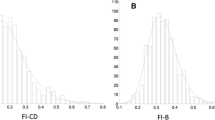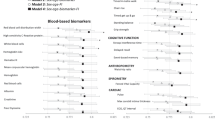Abstract
Frailty has been recognized as a common condition in older adults, however, there is scarce information on the association between frailty and commonly used biomarkers. The aim of this study was to assess the individual and cumulative association of biomarkers with frailty status. This is a cross-sectional analysis of the 2012 wave of the Mexican Health and Aging Study. A sub-sample of 60-year or older adults with anthropometric measurements was analyzed. Frailty was defined with a 31-item frailty index and those considered frail had a score ≥ 0.21. Biomarkers were further categorized as normal/abnormal and tested both one by one and grouped (according to their usual cutoff values). Adjusted logistic models were performed. A total of 1128 older adults were analyzed and their mean age was 69.45 years and 51.24% of them were women. 26.7% (n = 301) were categorized as frail. Individual biomarkers associated with frailty after adjusting for confounding were: hemoglobin [odds ratio (OR) 1.67, 95% confidence interval (CI) 1.13–2.46, p = 0.009], glycated hemoglobin (OR 2.04, 95% CI 1.54–2.7, p < 0.001) and vitamin D (OR 1.53, 95% CI 1.13–2.07, p = 0.005). Those with ≥ 4 abnormal biomarkers had an independent association with frailty when compared to those without any abnormal biomarker (OR 2.64, 95% CI 1.3–5.25, p = 0.005). Aside from the individual associations of specific biomarkers, our findings show that an incremental association of abnormal biomarkers increases the probability of frailty, accounting for the multidimensional nature of frailty and the possible interplay between components of the system that potentiate to give rise to a negative condition such as frailty.
Similar content being viewed by others
References
Morley JE, Vellas B, Van Kan GA et al (2013) Frailty consensus: a call to action. J Am Med Dir Assoc 14:392–397
Mitnitski A, Song X, Rockwood K (2013) Assessing biological aging: the origin of deficit accumulation. Biogerontology 14:709–717
Rockwood K, Theou O, Mitnitski A (2015) What are frailty instruments for? Age Ageing 44:545–547
Walston J, Hadley EC, Ferrucci L et al (2006) Research agenda for frailty in older adults: toward a better understanding of physiology and etiology: summary from the American Geriatrics Society/National Institute on Aging Research Conference on Frailty in Older Adults. J Am Geriatr Soc 54:991–1001
Carpenter CR, Shelton E, Fowler S et al (2015) Risk factors and screening instruments to predict adverse outcomes for undifferentiated older emergency department patients: a systematic review and meta-analysis. Acad Emerg Med 22:1–21
Gutierrez-Robledo LM (2002) Looking at the future of geriatric care in developing countries. J Gerontol A Biol Sci Med Sci 57:M162–M167
Blodgett JM, Theou O, Howlett SE et al (2017) A frailty index from common clinical and laboratory tests predicts increased risk of death across the life course. GeroScience 39:447–455
Rockwood K, Mcmillan M, Mitnitski A et al (2015) A frailty index based on common laboratory tests in comparison with a clinical frailty index for older adults in long-term care facilities. J Am Med Dir Assoc 16:842–847
Gutierrez-Robledo LM, Avila-Funes JA, Amieva H et al (2016) Association of low serum 25-hydroxyvitamin D levels with the frailty syndrome in Mexican community-dwelling elderly. Aging Male 19:58–63
Buta B, Choudhury PP, Xue QL et al (2017) The association of vitamin D deficiency and incident frailty in older women: the role of cardiometabolic diseases. J Am Geriatr Soc 65:619–624
Ensrud KE, Blackwell TL, Cauley JA et al (2011) Circulating 25-hydroxyvitamin D levels and frailty in older men: the osteoporotic fractures in men study. J Am Geriatr Soc 59:101–106
Ensrud KE, Ewing SK, Fredman L et al (2010) Circulating 25-hydroxyvitamin D levels and frailty status in older women. J Clin Endocrinol Metab 95:5266–5273
Orces CH (2017) Prevalence of clinically relevant muscle weakness and its association with vitamin D status among older adults in Ecuador. Aging Clin Exp Res 29:943–949
Puts MT, Visser M, Twisk JW et al (2005) Endocrine and inflammatory markers as predictors of frailty. Clin Endocrinol (Oxf) 63:403–411
Cesari M, Penninx BW, Pahor M et al (2004) Inflammatory markers and physical performance in older persons: the InCHIANTI study. J Gerontol A Biol Sci Med Sci 59:242–248
Virgini VS, Wijsman LW, Rodondi N et al (2014) Subclinical thyroid dysfunction and functional capacity among elderly. Thyroid 24:208–214
Fried LP, Xue QL, Cappola AR et al (2009) Nonlinear multisystem physiological dysregulation associated with frailty in older women: implications for etiology and treatment. J Gerontol A Biol Sci Med Sci 64:1049–1057
Cappola AR, Xue QL, Fried LP (2009) Multiple hormonal deficiencies in anabolic hormones are found in frail older women: the women’s health and aging studies. J Gerontol A Biol Sci Med Sci 64:243–248
Ferrucci L, Cavazzini C, Corsi A et al (2002) Biomarkers of frailty in older persons. J Endocrinol Investig 25:10–15
Wong R, Michaels-Obregon A, Palloni A (2017) Cohort profile: the Mexican Health and Aging Study (MHAS). Int J Epidemiol 46:e2
Wong R, Michaels-Obregon A, Palloni A et al (2015) Progression of aging in Mexico: the Mexican Health and Aging Study (MHAS) 2012. Salud Publica Mex 57:S79–S89
Searle SD, Mitnitski A, Gahbauer EA et al (2008) A standard procedure for creating a frailty index. BMC Geriatr 8:24
Garcia-Gonzalez JJ, Garcia-Pena C, Franco-Marina F et al (2009) A frailty index to predict the mortality risk in a population of senior Mexican adults. BMC Geriatr 9:47
Schalk BW, Visser M, Deeg DJ et al (2004) Lower levels of serum albumin and total cholesterol and future decline in functional performance in older persons: the longitudinal aging study Amsterdam. Age Ageing 33:266–272
Schoufour JD, Echteld MA, Boonstra A et al (2016) Biochemical measures and frailty in people with intellectual disabilities. Age Ageing 45:142–148
Castrejon-Perez RC, Aguilar-Salinas CA, Gutierrez-Robledo LM et al (2017) Frailty, diabetes, and the convergence of chronic disease in an age-related condition: a population-based nationwide cross-sectional analysis of the Mexican nutrition and health survey. Aging Clin Exp Res 30:935–941
Castrejon-Perez RC, Gutierrez-Robledo LM, Cesari M et al (2017) Diabetes mellitus, hypertension and frailty: A population-based, cross-sectional study of Mexican older adults. Geriatr Gerontol Int 17:925–930
Zuliani G, Volpato S, Romagnoni F et al (2004) Combined measurement of serum albumin and high-density lipoprotein cholesterol strongly predicts mortality in frail older nursing-home residents. Aging Clin Exp Res 16:472–475
Shardell M, Hicks GE, Miller RR et al (2009) Association of low vitamin D levels with the frailty syndrome in men and women. J Gerontol A Biol Sci Med Sci 64:69–75
Van Hemelrijck M, Harari D, Garmo H et al (2012) Biomarker-based score to predict mortality in persons aged 50 years and older: a new approach in the Swedish AMORIS study. Int J Mol Epidemiol Genet 3:66–76
Funding
The Mexican Health and Aging Study was supported in its 2012 version by National Institutes of Health/National Institute on Aging (R01AG018016, R Wong, PI).
Author information
Authors and Affiliations
Corresponding author
Ethics declarations
Conflict of interest
The authors declare that they have no conflict of interest.
Ethical approval
All procedures performed in the present study were in accordance with the ethical standards of the National Geriatrics Institute research committee and with the 1964 Helsinki declaration and its later amendments or comparable ethical standards.
Informed consent
Informed consent was obtained from all individual participants included in the study.
Additional information
Publisher’s Note
Springer Nature remains neutral with regard to jurisdictional claims in published maps and institutional affiliations.
Electronic supplementary material
Below is the link to the electronic supplementary material.
Rights and permissions
About this article
Cite this article
Pérez-Zepeda, M.U., García-Peña, C. & Carrillo-Vega, M.F. Individual and cumulative association of commonly used biomarkers on frailty: a cross-sectional analysis of the Mexican Health and Aging Study. Aging Clin Exp Res 31, 1429–1434 (2019). https://doi.org/10.1007/s40520-019-01127-4
Received:
Accepted:
Published:
Issue Date:
DOI: https://doi.org/10.1007/s40520-019-01127-4




